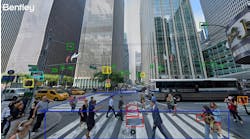By Andy Taylor, Contributing Author
When you think of the most unpleasant parts of road travel, traffic typically tops the list. There are many ways countries and cities are trying to mitigate this issue, but some are still missing the mark when it comes to effectiveness. Case in point, the widening of the Pennsylvania Turnpike.
The Pennsylvania Turnpike was buoyant that its team was adding new lanes to its turnpikes to improve capacity, but this is not a future-proofed mindset. Trying to build your way out of congestion may somewhat solve the problem short-term, where you’ll induce demand for a short period, but then ultimately increase the environmental issues in the long-term. More tarmac is not the answer.
As noted in the Pittsburgh Post-Gazette, it is said that the Pennsylvania interchange being built between Irwin and Monroeville is intended to help bring commercial and industrial development to the area, which has had substantial residential growth the last three decades. The turnpike is also set to widen to three lanes in each direction between the two towns.
It will serve Pennsylvania, the needs of its residents, and the collective whole much better to invest in improved intermodal solutions and the public transport networks. While at a recent Transportation Summit panel in Pennsylvania, I surveyed the room, and it was clear the attendees weren’t all practicing what the conference preached. It was revealed that only a small percentage of people used public transportation to get to the event. That is the exact issue we are working so diligently to overcome. People will naturally default to their cars when public transportation is not efficient for their journey.
Pennsylvania is quite rural. As such, public transportation, combined with private mobility, needs to be addressed. The use of park-and-ride facilities needs to be promoted to remove city congestion but also allow people to commute from rural areas to the large conurbations.
Legislation requiring electric vehicle drivers to pay for the wear and tear they inflict on Pennsylvania’s roads and highways in the form of a $250 annual fee is not helping matters either. The thought of taxing electric vehicles will not fill the infrastructure gap that exists. Cars are becoming more efficient, which will only lead to declining revenues. Tim Hennesey, a PA state senator, thinks that this is the option, but they need to consider ‘road user charging’ to fund the infrastructure in the future.
Reporting in the Pennsylvania Capital-Star shows that Pennsylvania pays for most of its highway and road improvements with its gas tax, which happens to be the highest in the nation. Owners of plug-in electric vehicles are supposed to submit monthly statements of their electricity use to the state Department of Revenue and remit the alternative fuel tax. A memo from Representative Mike Carroll states that most electric vehicle owners don’t do this because the process for remitting the alternative fuel tax is cumbersome, or they are unaware that they have to.
There are better ways to mitigate traffic congestion that do not include widening or creating more roads. Due to our individualistic culture, it is understandable that Americans are hesitant to give up the convenience a car provides and begin relying on public transportation like buses and subways. This is where intelligent traffic technology can help.
Modern solutions provide horizon-to-horizon computer vision tracking to actuate intersections and help solve complex problems such as adaptive traffic signal control. Cities like Seattle, Tacoma, San Francisco, and Reno have adopted intelligent transportation systems (ITS) technology to improve traffic flow. Minnesota’s DoT has seen great improvements in their detection capabilities through the use of ITS as it captures data on vehicle counts and classifications, as well as identifying driver patterns to improve congestion and road safety.
The Los Angeles-Long Beach-Anaheim region has been known as the worst U.S. city for traffic, but the New York-Newark area now claims the top spot with nearly 495,000 hours as the total time stuck, according to a report by Texas A&M University. This segways nicely into two real-world examples of how this technology is being put to good use:
UC San Diego - To address traffic congestion, UC San Diego invested nearly $2 million to implement adaptive traffic signal controls at 26 intersections along five miles of roadway surrounding the campus. This project is in the near-deployment stage for one of San Diego’s most extensive ITS projects to date.
MTA - New York is finding ways to alleviate the vehicular mayhem post-pandemic. One way they are doing this is to introduce a congestion pricing program in which tolls will collect a fee from drivers entering certain sections of Manhattan, usually during peak hours. In this case, toll roads take on a dual purpose: to raise revenue and control traffic via sensors and detection tools.
ITS will continue to be a necessity when solving congestion issues in the future. The growing problem of road congestion in the U.S. won’t be solved overnight. However, by tapping into smarter technology and a willingness from the public to shift to using more sustainable transportation methods, road congestion can be greatly reduced and hopefully become an issue of the past.
The overarching and important points we have yet to bring up are Mobility on Demand (MOD) and Mobility as a Service (MaaS). Most global transit leaders believe MOD and MaaS are ways to encourage riders to take public transportation. It’s important to note that MaaS has to be achieved by evolution and not revolution. The evolution of MaaS, MaaS 2.0 is where cities and public agencies are realizing that integrating some private mobility, on an incremental basis, could help deliver a flexible and resilient mobility for the end-user.
As you can see, there are many cities and states that are paving the way for smarter transportation of the future. These examples do not involve creating a short-term solution as an attempt to fix a long-term issue. RB



